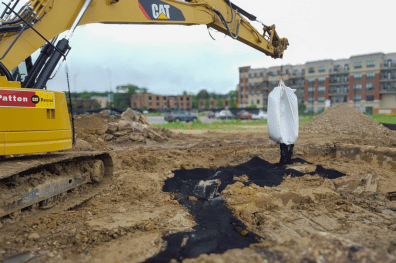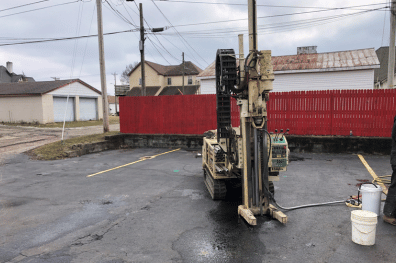ORIN successfully treated highly contaminated unsaturated soils using BAM treatment material in combination with chemical oxidation. The treatment chemistries were applied while simultaneously mixing the soils with an excavator. Approximately 720 yd3 of soil were treated and removed from the site during treatment efforts. An initial 3 feet of clean overburden was removed.
The underlying contaminated soils were mixed in-situ within the excavation. Treatment extended from 3 feet below ground surface (ft-bgs) to approximately 12 ft-bgs. Baseline samples were first taken prior to treatment to characterize the contaminant level. Treated soil samples were then sent to a commercial laboratory for analytical testing.
The Challenge
The site presented specific remediation needs:
- 720 cubic yards of contaminated soil
- PCE contamination with free product areas
- Depth: 3 to 12 feet below ground
- Need for non-hazardous disposal classification
- TCLP compliance requirements
- Comprehensive sampling needs
The Solution: Strategic Treatment Approach
The team implemented a systematic cleanup strategy:
- Site Preparation:
- 3-foot clean overburden removal
- Excavation area preparation
- Treatment zone identification
- Sampling protocol establishment
- Treatment Implementation:
- BAM material application
- Chemical oxidation integration
- Simultaneous excavator mixing
- In-situ treatment within excavation
- Continuous process monitoring
Quality Control Process
Comprehensive sampling protocol:
- Seven sample sets collected
- One sample per 100 cubic yards
- Total PCE analysis
- TCLP PCE testing
- Laboratory verification
Impressive Results
The treatment achieved stringent targets:
- Free Product Areas:
- Highest readings: 20 ppm and 13 ppm
- All other areas below 10 ppm
- TCLP Results:
- All areas below detection limits
- Non-hazardous classification achieved
- Local landfill disposal approved
Key Success Factors
Several elements contributed to project success:
- Strategic treatment combination
- Comprehensive sampling program
- Effective mixing methodology
- Quality control measures
- Systematic implementation
Innovation Highlights
The project demonstrated several advantages:
- Effective free product treatment
- Consistent results across treatment area
- Successful TCLP reduction
- Cost-effective disposal solution
- Efficient treatment process
Practical Applications
This success provides solutions for:
- Dry cleaner site remediation
- PCE contamination
- Urban site cleanup
- Hazardous soil treatment
- TCLP compliance achievement
This case study demonstrates how innovative treatment approaches can transform hazardous dry cleaner sites into manageable, non-hazardous materials suitable for conventional disposal.



